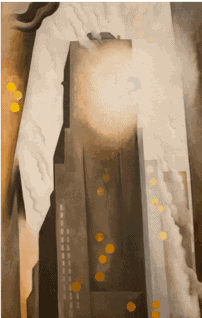Are We Really Going Down?

Considered as one of the sharpest art market observers and contributors of Artnet, Tim Schneider has recently published some thoughts that link the correction of the art market with NYC’s high-end condo-sales recession.[1] Last Friday, The New York Times published an article which revealed that one in four condo units built in NYC since 2013 remains empty. Furthermore, there was a 35% drop in the number of contracts signed for new developments above the $4M mark compared to the last year.[2] Coincidently, the recently published Artnet’s Intelligence Report found that the artworks auctioned over the $10M contracted by 35% against last year’s results.[3] Therefore, the author of The Gray Market suggests that NYC’s Real Estate crisis could hold a consonance with the art market.
However, in a deeper examination of this report, such weakness refers to the lack of offer, and therefore the lack of sale results. Although the BI% is stable, the drop is mainly due to a correction to the usual business after the Rockefeller estate sale last year. This “once in a lifetime auction” (as Christie’s accurately titled the sale) inflated last year’s results with an $800 M collection. As a result, this year’s usual business shows a 40% drop in the Impressionist & Modern sector and 20% in the Post War & Contemporary department.
Art’s uniqueness is key in differentiating both trends in the market. In Real Estate, the supply is fixed (elastic) to pricing at the moment. In art, the supply is very selective (inelastic) while the demand is elastic. That is to say, from an investor’s point of view, if you have $10 million and want to allocate them in alternative investments to diversify their portfolio, you can likely find thousands of options in Real Estate suitable to your taste. But if you try to look in the art market for investment-type $10 million-dollar artworks, your options will reduce to a couple of dozen artworks.
The core of the analysis should rely on the offer. The 35% drop in RE contracts is not due to a lack of demand but from excess in the offer. Real Estate developers know that land is a limited asset. However, by building towards the sky they magically transform their asset into a much larger asset. Although it is widely recognized that HNWI are in constant increment, they are probably increasing at a lower rate than New York’s condo developments. The main difference with art –especially in the above $10 million market–, is that there is no possible way to divide or increase the offer.
Precisely because it is selective, a 35% contraction in Art is most likely due to a contracting supply and not BI rates or works failing to sell. This statement was confirmed by the new study of Pi-eX confirming that: “Although the second quarter of 2019 was below the total for 2018, the key difference in outcomes was not a decline in the market but the absence of some huge private collections sold during the period. From 2016, when the market went through a dramatic reset, to the present, there has been a steady rise in fine art sales. The Q2 total for Fine Art was about the same in 2018 and 2019 if you remove private collections like the massive Rockefeller sale and the Mandel collection. That plateau was still higher than in 2017 and 2016. So the market’s fall this year is better understood as a return to trend.”[4]
Moreover, art is portable, finite, and can be hedged against inflation and currency fluctuations; while Real Estate is not portable, certainly not finite, and though it can be hedged against inflation, it cannot be shielded from currency fluctuations. Besides, NYC’s developers did not timely identify the toughening in the regulations and compliance being imposed on foreign buyers, which has created an oversupply in the city.
It seems a little far-fetched to compare these assets, one being generally perceived as an asset of pleasure and the Real Estate perceived as a necessity. Alongside the numerous differentiating factors of tax treatments and rates, both have very different compliance and business models.

The dissimilar marketplace should also be taken into consideration for the analysis. The consumers that purchase $4 million listed properties are not the same consumers interested in $10 million artworks. An art investor/collector that buys an artwork for over $10million is probably a sophisticated consumer or investor. While a person that signs a $4 million-dollar property contract in New York, might probably just looking to reduce the commuting time to work.
A decline in $4 million-dollar Real Estate sales or $10 million-dollar artworks is not representative or predictive of an economic recession. Both markets are very specific and unique. Maybe they account for a large market share in their respective industries, but in volume terms, they are a very small observation compared to the overall markets. Nevertheless, Schneider’s article should be considered as a stride in the development of better alternative investment analysis. The implementation of these forward-thinking concepts in the industry will certainly help the business practices and bring light to the economy.


[1] Schneider , Tim. “‘Blank Space.’” The Gray Market, 16 Sept. 2019, https://mailchi.mp/5e386ce5bdcf/the-gray-market-weekly-217-high-rises-make-for-hard-falls?e=ae3a2647fc.
[2] Chen, Stefanos. “One in Four of New York’s New Luxury Apartments Is Unsold.” The New York Times, 13 Sept. 2019, https://www.nytimes.com/2019/09/13/realestate/new-development-new-york.html.
[3] Halperin, Julia. “Intelligence Report Fall 2019.” Artnet, 16 Sept. 2019, http://www.artnet.com/artnet-intelligence-report/.
[4] “Overview Report in the Second Quarter of the Calendar Year over the Last Ten Years (2010 to 2019) .” Pi-EX ,https://pi-ex.mybigcommerce.com/auction-reports/annual-quarterly-monthly-reports/quarterly-reports/second-quarter/.
